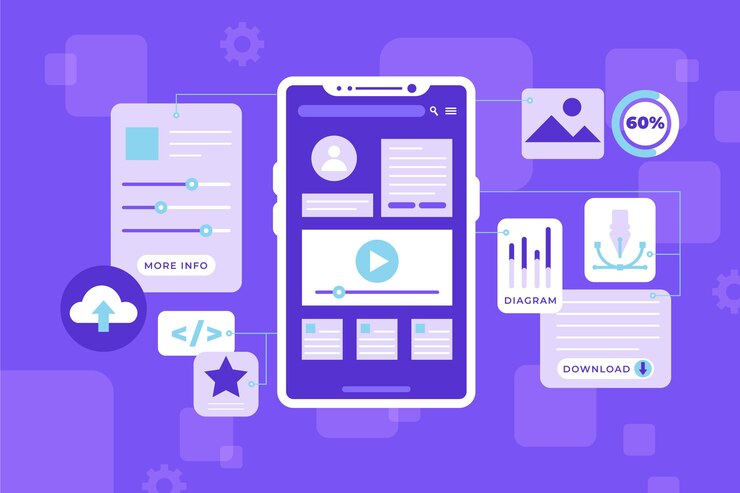All You Need to Know About Backend Development for Mobile Apps
 Syed Zohaib Akhter
Syed Zohaib Akhter
Only with strong backend development is it feasible to create a mobile application with a visually appealing but basic user interface. For mobile applications, the backend is similar to the app's foundation. It and the frontend of a mobile app are symbiotic, meaning that one can only function successfully without the other. Because of this, frontend and backend tools for developing apps are more valuable than they have ever been.
Backend engineers will become more and more valuable as more companies employ websites and mobile applications to boost their online presence. To get the greatest results, business owners need to know precisely which backend development tool to use and how each one fits into the process of developing a mobile app.
What is Mobile App Backend Development?
The server-side development of an app is called mobile app backend development. Mobile app backend frameworks are made up of an application, database, and server that work together to handle data that comes in via the frontend. In order to optimize the frontend responsiveness for users, the backend reacts to such information remotely. An engine on a motorcycle, for instance, would be considered its backside. Without its engine, a motorcycle cannot operate, and mobile applications depend on backend frameworks to maintain frontend functionality.
The functioning, security, data processing, and storage of a mobile application are among the critical tasks that the backend server of the app does.
By analogy with the bicycles that operate without an engine, the applications that do not need or have the backend are similar. Mobile app backend services are required for every application that has push notification, user data storage, login/signup, and authentication functionalities.
For mobile applications, the backend saves the app and sends a response to the frontend so that it may show it to the user. For instance, the backend promptly transmits the information request to the backend when you click on a certain sector, such as clothing for men or women, in the Amazon app. Requests are processed by the application backend, which also searches the database of men's and women's clothing. After that, it offers the finest choices, which the frontend shows the users.
The database, application scripting, architecture, data processing, data sharing, security, database updates, and user data authentication are all managed by the mobile app backend server.
Frontend and backend differences
An application's frontend code creates its user interface, while the backend code controls the backend's functionality. App visual elements such as font, color, line, shape, form, sliders, and texture are the main emphasis of frontend code. These elements are created by their creators using HTML, CSS, and JavaScript.
Server-side features, such as database administration, data storage, and security, make up the backend. The backend serves as the foundation that the frontend needs to run efficiently and guarantee that the user has a positive app experience. Only mobile backend services can support the effective operation of an app and its user interface.
Applications that work without a backend
Some applications don't have a backend since they don't need data storage or the internet to work.
Apps Requiring a Backend to Operate
A backend is necessary for any software that uses the internet, stores, exchanges, and requires user authentication in order to run properly.
Different Kinds of Backend Solutions
Depending on your needs, the process of developing a mobile app's backend may involve several backend frameworks. You may select one that satisfies all of your criteria by carefully examining them to see how they all work with the frontend applications. Ultimately, you should be primarily concerned with the backend software's scalability and dependability.
SaaS, or software as a service
For the frontend applications, a variety of third parties and Software as a Service (SaaS) providers provide backend functionality options. A monthly or yearly membership charge could be required in order to use this ready-to-use backend solution. Your app will be ready to use with a working backend as soon as you subscribe to it and link it with the frontend. Additionally, the SaaS makes frontend app API connection easier.
As a Service: Mobile Backend (MbaaS)
Security, an application server, and a database are examples of backend solutions. The ability to alter the code using pre-built backend tools and APIs is what sets Mobile Backend as a Service (MbaaS) apart. This feature allows you to add and remove app functionalities based on your needs. Apps requiring user identification, data storage, and push alerts need a dependable backend, which MbaaS can provide.
Owners of frontend applications may adapt their apps to changing business needs with the support of MBaaS's custom code capabilities. A monthly charge is required, which varies according on how MbaaS solutions are used, such as user slot consumption and alerts.
Personalized Mobile Backend System
Complex feature app development is best served by a specialized mobile backend solution. Custom solutions allow you to customize every aspect of the app backend to your precise specifications.
However, the needs for the app might sometimes be too complicated, which is why skilled backend developers will be needed to construct a specific backend solution.
Content Management Systems without a head
Apps that need media, such as words, photographs, or videos, might profit from CMS backend development services. According to Future industry Insights, the headless CMS software industry is expected to reach a valuation of $605 million by 2024.
You may create a frontend framework with a unique design and media with the aid of a headless CMS.
APIs included with CMSs make it quicker and simpler to create and manage content.
Your app may also be compatible with several platforms if it has a headless CMS backend.
Using a headless content management system as your app's backend will help improve its security and scalability.
Benefits of Developing Backend Systems
For many complicated applications, backend app development is a crucial component. The frontend controls the app's user interface, while the backend decides how the application will work and satisfy the demands of the user.
The following are some common advantages of backend development:
Improved Communication of Information
An application's backend facilitates seamless communication between its internal and external components, boosting the effectiveness of information exchanges that occur inside.
Quick Development Method
Since the backend is essentially the application's brain, developing it methodically expedites the other stages of development.
Improved Functionality on the Front End
The backend optimizes an application's internal procedures to support and mechanize the frontend's operations, hence enhancing the frontend's user experience.
Enhanced Performance of the App
Your mobile application's backend is its brain, as was previously discussed. In order to provide the best solutions, it processes the data that the user requests via the front end. Developing a backend that works effectively might aid in producing mobile apps that run smoothly.
Applications for Android Backend Development Tools
Backend solutions from well-designed backend software are necessary for Android applications. To choose the ideal one for your needs, you may go at the top backends for Android apps.
Firebase
Parse
AWS, or Amazon Web Services
Reverse4App
App Engine for Google
Heroku
Resources for Backend Development of iOS Apps
iOS data synchronization and storage might be tricky if you don't choose the right software based on your app's needs.
You may choose from the following iOS backend development technologies:
Amazon Enhance
Firebase
Rest API
CloudKit
StackMob
Reverse4App
Parse
GraphQL
Tech Stack for Developing Mobile Apps on the Backend
Skilled developers are needed for both simple and advanced mobile backend development. Onshore or individual hiring of these developers might be expensive for a project with a certain budget. For mobile backend development, you may hire offshore engineers. For much less money, they provide development options that are comparable. With skilled backend developers, selecting the appropriate technology for your mobile app's backend architecture is very simple. To make sure you are going in the proper route, familiarize yourself with the tech stack.
The following tech stacks are possible prerequisites for backend development:
**The Backend Development Tech Stack
Last Thought**
The kind of backend your app will need to run properly may be determined with the aid of the app requirements. A complicated app that requires updates every other month may simply need ready-to-use SaaS backend solutions; however, an MBaaS or bespoke mobile backend solution will be required for an app with basic/standard functionality. If you are searching for top-notch app developers Los Angeles has a lot of expertise that is capable of developing mobile programs that are distinctive and user-friendly.
Subscribe to my newsletter
Read articles from Syed Zohaib Akhter directly inside your inbox. Subscribe to the newsletter, and don't miss out.
Written by

Syed Zohaib Akhter
Syed Zohaib Akhter
A highly skilled software developer with a strong foundation in designing, developing, and maintaining software applications. Proficient in multiple programming languages and frameworks, including Java, Python, and JavaScript. Experienced in utilizing industry best practices and coding standards to deliver high-quality code. Collaborative team player with excellent problem-solving and communication skills, able to work effectively in cross-functional teams. Passionate about continuous learning and staying up-to-date with the latest technologies and trends in software development.